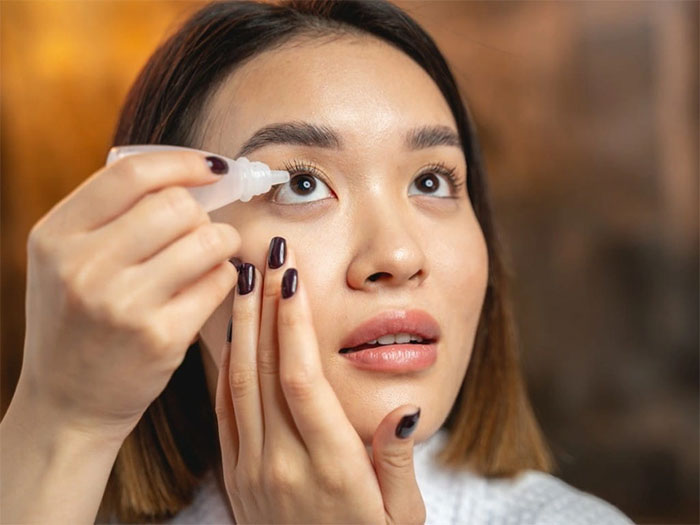Dry eye can affect one or both eyes with symptoms such as eye pain or discomfort, blurred vision, and increased sensitivity to light.
According to Medical News Today (MNT), dry eye occurs when the eyes produce too few tears or when tears evaporate too quickly. Dry eye can range from mild to severe. Mild cases may be treated with over-the-counter (OTC) remedies, while more severe cases may require prescription medications.
Symptoms of Dry Eye

Some symptoms of dry eye include quick eye fatigue, redness, excessive tearing, or sensitivity to light. (Image: Provision).
Dry eye syndrome can cause a range of symptoms including: redness or pain, excessive tearing, a stinging or burning sensation in the eyes, a gritty feeling, mucus in or around the eyes, sensitivity to smoke, wind, or light, blurred vision, and double vision.
Additionally, eye fatigue after reading for even a short time, difficulty keeping the eyes open, discomfort when wearing contact lenses, or eyelids sticking together upon waking are common symptoms of dry eye.
Some individuals may experience intense eye pain, leading to anxiety and difficulty performing daily activities.
Risk Factors for Dry Eye
According to MNT, several factors can increase the risk of developing dry eye, including:
Eyebrow Issues
Each time you blink, the eyelids spread a thin layer of tears over the surface of the eye. Eyelid issues that can affect blinking include:
- Ectropion: A condition where the eyelid turns outward
- Entropion: A condition where the eyelid turns inward
- Blepharitis or inflammation of the eyelids
Wearing contact lenses can also affect blinking and cause dry eye.
Other Medical Conditions
Several medical conditions can reduce tear production, including vitamin A deficiency, diabetes, radiation therapy, or autoimmune diseases such as Sjögren’s syndrome, lupus, scleroderma, and rheumatoid arthritis.
Environmental Factors
Certain environmental factors can impact the evaporation rate of tears, such as dry, hot, or windy weather, air conditioning, high altitudes, exposure to smoke, and wearing contact lenses.
Other environmental factors that can increase visual concentration and slow the blinking rate, leading to dry eyes, include using a computer screen, reading, or driving.

Environmental factors can increase visual concentration and slow the blinking rate, causing dry eyes. (Image: Stoneycreekeyecare).
Treatment for Dry Eye
Treatment for dry eye aims to:
- Restore or maintain proper tear levels
- Reduce dryness and discomfort
- Maintain overall eye health
Depending on the underlying cause of dry eye, treatment may include one or more of the following methods:
Adding Tears
Individuals with dry eye may treat mild cases by using over-the-counter artificial tears. Pharmacists can recommend the most suitable products for use.
In general, people should avoid products containing preservatives and other additives as they may further irritate dry eyes.
Using eye drops before engaging in activities that may worsen dry eye symptoms can be helpful. Additionally, using ointments at night may temporarily blur vision.
Conserving Tears
The goal of this method is to keep tears in the eyes longer to prevent dry eye. This may involve blocking the tear drainage ducts from the eyes.
Temporary solutions include blocking the tear ducts with small gel or silicone plugs. A more permanent solution is surgical closure of the tear ducts.
Increasing Tear Production
Doctors may prescribe eye drops to increase tear production. Individuals with severe or persistent dry eye may need to take oral cyclosporine (Restasis, Cequa) or eye drops containing lifitegrast (Xiidra).
Treating Underlying Conditions
How a doctor addresses underlying conditions that may cause dry eye will depend on the specific illness. A doctor may prescribe antibiotics to treat bacterial blepharitis or adjust a person’s autoimmune treatment plan for better disease control.

Individuals with dry eye may treat mild cases by using over-the-counter artificial tears. (Image: Poison).
Home Remedies
At-home eye care can help alleviate some symptoms of dry eye. Doctors may recommend:
- Cleaning the eyelids with prescription eyelid cleansers to remove oil and bacteria
- Applying warm compresses to the eyelids to reduce pain or discomfort
- Gently massaging the eyelids
Dietary Changes
According to the National Eye Institute (NEI), a deficiency in vitamin A or omega-3 fatty acids can increase the risk of dry eye. Furthermore, research shows that supplementing with vitamin A or omega-3 may help treat existing dry eye cases.
A small 2019 study with 30 men suffering from dry eye found that short-term vitamin A supplementation improved tear quality but did not increase tear quantity.
Sources of vitamin A include liver, fatty fish, eggs, cheese, milk and yogurt, red vegetables, and leafy greens.
A 2019 meta-analysis of 17 randomized clinical trials found that omega-3 fatty acid supplementation significantly improved signs and symptoms of dry eye compared to placebo.
Sources of omega-3 include fatty fish, seafood, flaxseeds, soybeans, and canola oil.
Preventing Dry Eye
According to the American Optometric Association, some ways to help prevent dry eye include:
- Blinking frequently when reading or staring at a computer screen for extended periods.
- Wearing wraparound sunglasses outdoors to protect against environmental factors that cause dry eye.
- Avoiding dry outdoor environments.
- Using a humidifier to increase moisture indoors at work and home.
- Drinking plenty of water to avoid dehydration.
- Consulting a doctor about which supplements to take for dry eye.
Video: Brave confrontation with a lion, calf meets a tragic end


















































